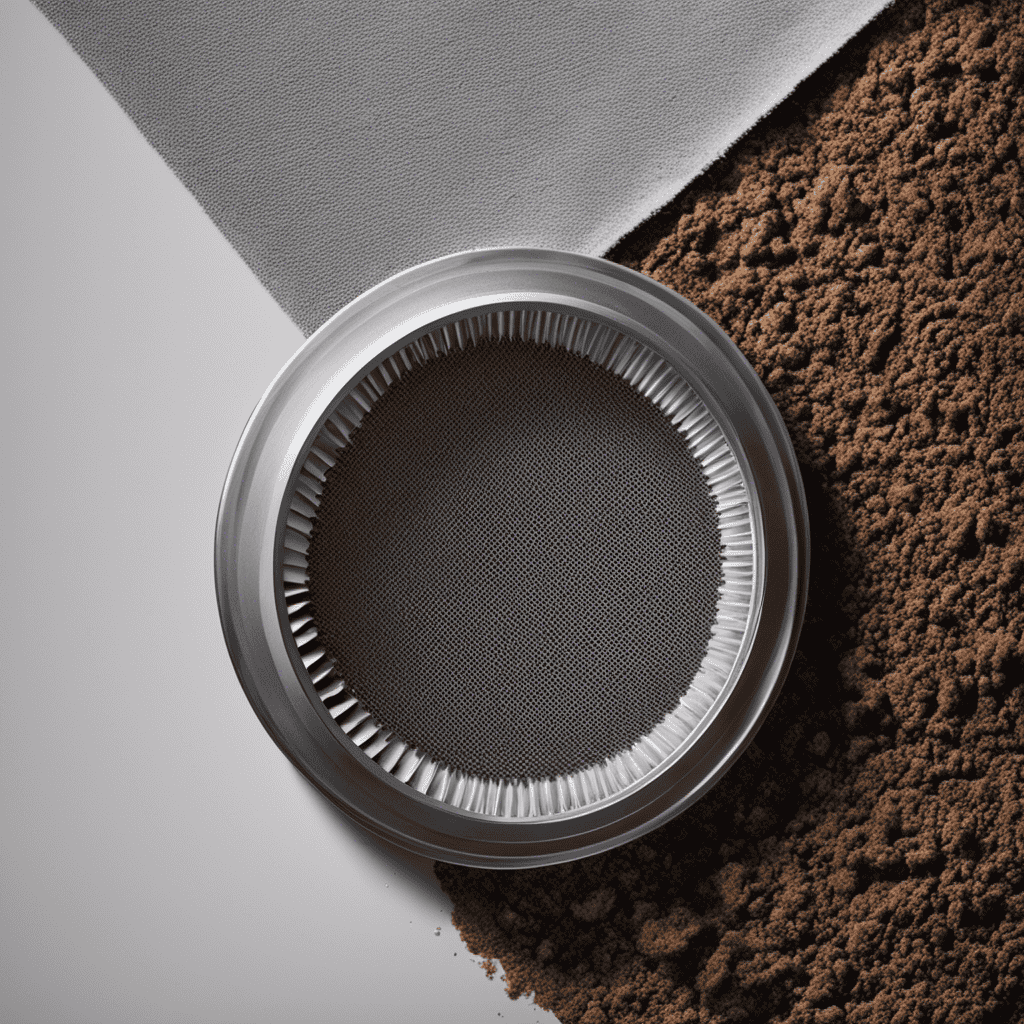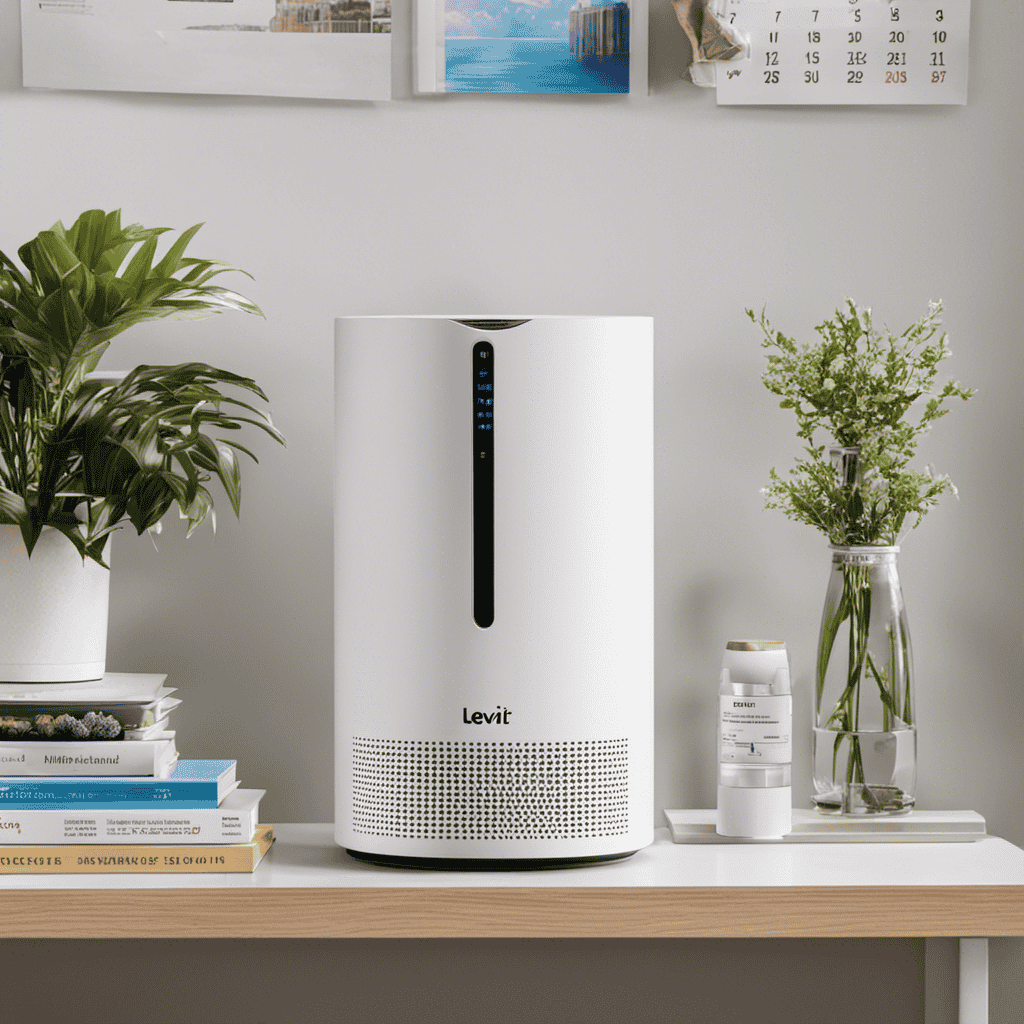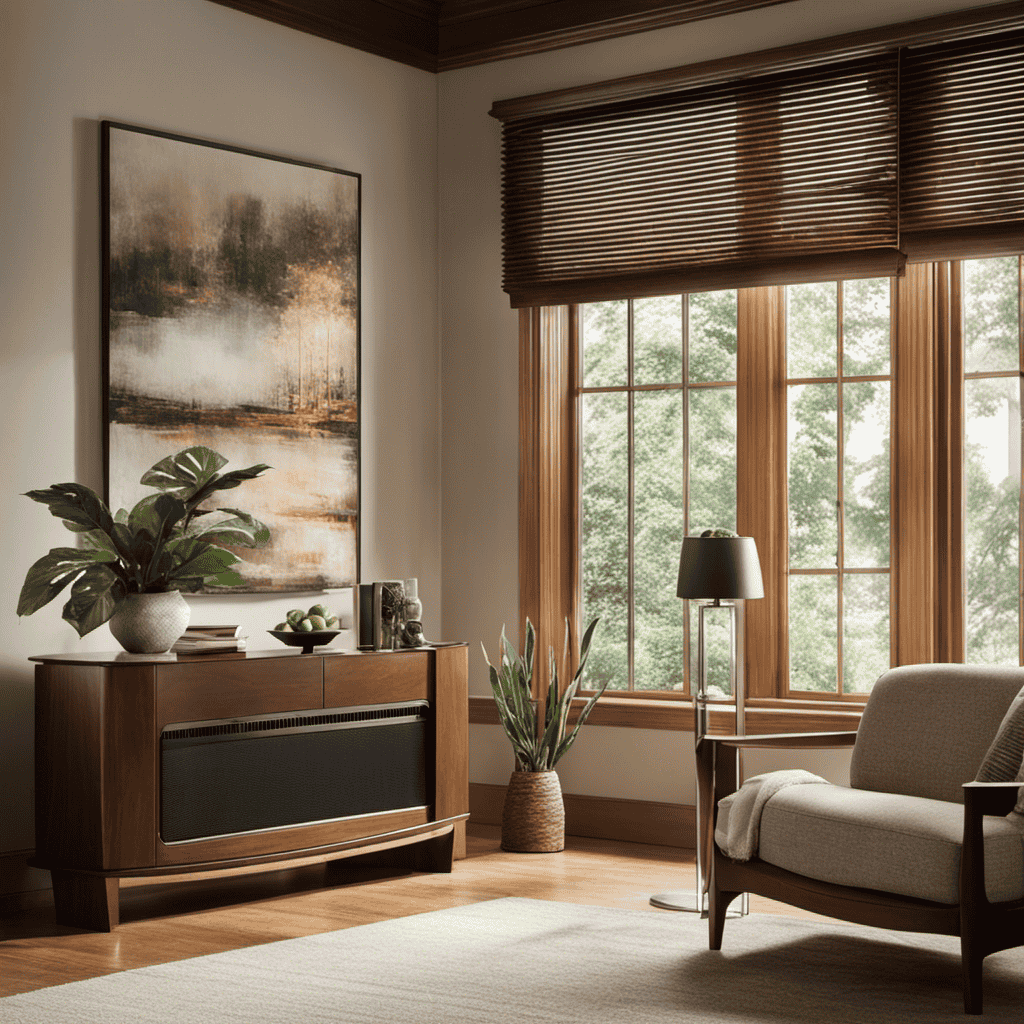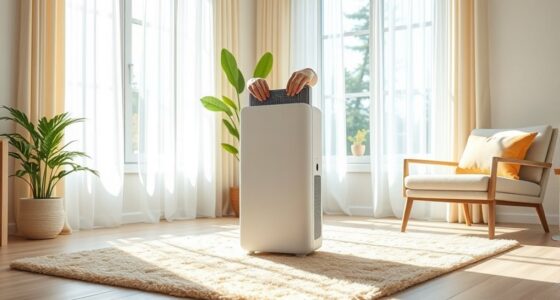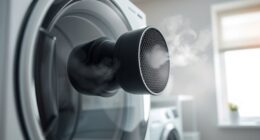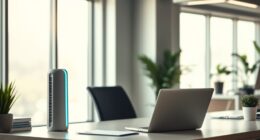I understand what you’re pondering: how frequently do I actually need to replace the HEPA filter in my air purifier? Let me tell you, it’s crucial.
Regularly changing your HEPA filter is crucial for maintaining indoor air quality and ensuring that your air purifier is working efficiently. In this article, I’ll delve into the factors to consider when determining filter replacement frequency, recommended intervals for different brands, signs that indicate it’s time for a change, and tips to extend the lifespan of your filter.
Let’s get started!
Key Takeaways
- Recommended filter maintenance provided by the manufacturer
- Impact of air quality on filter lifespan
- Visual inspection of dirty or discolored filter
- Importance of regular filter replacements for air purification effectiveness
Factors to Consider When Determining Filter Replacement Frequency
When determining how often to change your HEPA filter in an air purifier, there are several factors you should consider.
One of the most important factors is the recommended filter maintenance provided by the manufacturer. Each air purifier model may have different guidelines for filter replacement, so it is essential to refer to the user manual or manufacturer’s recommendations. Following these guidelines ensures that your air purifier is functioning optimally and effectively removing pollutants from the air.
Additionally, the impact of air quality on the filter lifespan is another crucial factor to consider. If you live in an area with high levels of pollution or have frequent exposure to smoke, pet dander, or other airborne particles, your HEPA filter may get clogged more quickly. This can reduce its efficiency in capturing pollutants and may require more frequent filter replacements. On the other hand, if you live in an area with relatively clean air or use the air purifier in a less polluted environment, the filter may last longer.
To determine the ideal filter replacement frequency, it is recommended to monitor the air quality in your surroundings and keep an eye on the filter’s performance. Signs that indicate the need for a filter change include reduced airflow, a noticeable decrease in air purification effectiveness, or a visual inspection showing a dirty or discolored filter.
Recommended Filter Replacement Intervals for Different Air Purifier Brands
The recommended intervals for replacing filters vary among different air purifier brands. It is important to follow the manufacturer’s guidelines to ensure optimal performance and efficiency of your air purifier.
Here are some key points to consider when it comes to filter replacement:
-
Different brands have different recommendations: Each air purifier brand may have its own specific guidelines for filter replacement. It is crucial to refer to the user manual or contact the manufacturer to determine the recommended intervals.
-
Filter replacement costs: Filter replacement costs can vary depending on the brand and model of your air purifier. It is essential to factor in these costs when considering the overall maintenance and operation of your air purifier.
-
Common misconceptions about filter replacement: There are a few misconceptions surrounding filter replacement. Some people believe that filters can last indefinitely or that they only need to be replaced when visibly dirty. However, filters have a lifespan and should be replaced regularly to maintain the air purifier’s effectiveness in removing pollutants and allergens from the air.
Signs That Indicate It’s Time to Change Your Hepa Filter
To ensure clean and healthy air, it’s important to pay attention to certain signs indicating it’s time for a HEPA filter replacement.
HEPA filters play a crucial role in trapping and removing harmful pollutants, allergens, and particles from the air we breathe. Over time, these filters can become clogged and less effective, reducing their ability to maintain clean air.
One indication that it’s time to change your HEPA filter is a noticeable decrease in air quality. If you start noticing more dust, pet dander, or unpleasant odors lingering in the air, it may be a sign that your filter is no longer working optimally.
Another indication is decreased airflow from your air purifier. If you find that the airflow has significantly weakened, it could be due to a clogged filter that needs to be replaced.
Regularly replacing your HEPA filter has several benefits, including improved indoor air quality, reduced allergens, and better respiratory health. By ensuring clean and fresh air, you can create a healthier environment for yourself and your loved ones.
In the subsequent section, we will discuss how to extend the lifespan of your HEPA filter and maximize its effectiveness in purifying the air.
How to Extend the Lifespan of Your Hepa Filter
One way you can maximize the effectiveness of your HEPA filter and extend its lifespan is by regularly cleaning it. Cleaning your HEPA filter not only helps to maintain its efficiency but also ensures that it lasts longer, saving you money in the long run.
Here are three simple steps to clean your HEPA filter:
-
Step 1: Remove the filter from your air purifier. Check the manufacturer’s instructions for guidance on how to safely remove the filter.
-
Step 2: Gently vacuum the surface of the filter to remove any visible dust and debris. Be careful not to damage the delicate filter fibers.
-
Step 3: Rinse the filter with water to remove any remaining particles. Use a gentle stream of water and avoid using any harsh cleaning agents that could potentially damage the filter.
Regularly cleaning your HEPA filter offers several benefits. Firstly, it helps to maintain the filter’s efficiency and ensures that it continues to effectively remove airborne particles such as dust, pollen, and pet dander. Secondly, a clean filter promotes better air quality, reducing the risk of respiratory issues and allergies. Lastly, by extending the lifespan of your HEPA filter, you can save money on frequent filter replacements.
The Importance of Regularly Changing Your Hepa Filter in Maintaining Indoor Air Quality
Regularly replacing your HEPA filter is crucial for maintaining the quality of indoor air. HEPA filters are designed to capture and remove small particles, such as dust, pollen, pet dander, and even bacteria, from the air. This helps to improve the overall air quality in your home and reduce the risk of respiratory problems and allergies.
The benefits of using HEPA filters in air purifiers are numerous. They are highly effective at removing airborne pollutants, ensuring that the air you breathe is clean and healthy. HEPA filters have been proven to capture up to 99.97% of particles as small as 0.3 microns in size. This includes common allergens like pollen, mold spores, and pet dander, as well as larger particles like dust and dirt.
On the other hand, poor indoor air quality can have a significant impact on your health. It can lead to a variety of respiratory issues, such as allergies, asthma, and even lung cancer. Indoor air pollutants can also cause headaches, fatigue, and worsen existing health conditions.
To emphasize the importance of regularly changing your HEPA filter, here is a table that highlights the potential health risks associated with poor indoor air quality:
| Health Risks |
|---|
| Allergies |
| Asthma |
| Lung Cancer |
| Headaches |
| Fatigue |
Is the Hepa Filter in an Air Purifier the Same as the Regular Air Purifier Filter?
No, the Hepa filter in an air purifier is not the same as the regular air purifier filter. The Hepa filter is designed to capture smaller particles and is more efficient at trapping air pollutants. Therefore, it may not need to be changed with the same frequency of air filter changes as a regular filter.
Frequently Asked Questions
Can I Clean My HEPA Filter Instead of Replacing It?
Cleaning a HEPA filter instead of replacing it can have its advantages. It can help extend the lifespan of the filter and save money in the long run. However, there are factors to consider when deciding whether to clean or replace the filter.
These include the level of pollutants in the air, the manufacturer’s recommendations, and the overall condition of the filter. It’s important to follow the manufacturer’s guidelines and ensure proper cleaning techniques to maintain optimal air purification.
What Are Some Common Allergens That a HEPA Filter Can Remove From the Air?
Using a HEPA filter in your air purifier offers numerous benefits. It efficiently traps common allergens like pollen, pet dander, and dust mites, improving indoor air quality.
One interesting statistic is that HEPA filters can remove up to 99.97% of particles as small as 0.3 microns.
To choose the right HEPA filter for your needs, consider the CADR rating, room size, and the specific allergens you want to target.
Regularly changing the filter is essential for optimal performance.
Is It Necessary to Change the HEPA Filter if I Only Use My Air Purifier Occasionally?
It is important to consider the frequency of use when determining how often to change the HEPA filter in an air purifier. If you don’t use your air purifier often, you may not need to change the filter as frequently as someone who uses it daily.
However, it is still recommended to follow the manufacturer’s instructions for filter replacement. These instructions are typically based on the average lifespan of the filter, which is usually around 6 to 12 months.
Can I Use a HEPA Filter for Longer Than the Recommended Replacement Interval?
I’ve always wondered if I could use a HEPA filter for longer than the recommended replacement interval. It’s tempting to save some money and not replace it regularly, but I wanted to know what would happen if I didn’t.
After doing some research, I found that reusing a HEPA filter is not recommended. Over time, the filter becomes less effective at capturing airborne particles, which can lead to decreased air quality in your home.
It’s best to stick to the manufacturer’s recommendations and replace the filter regularly for optimal performance.
Are There Any Health Risks Associated With Not Changing the HEPA Filter Regularly?
Not changing the HEPA filter regularly can have potential health risks.
Over time, the filter becomes less effective at removing harmful particles such as dust, pollen, and pet dander from the air.
This can lead to increased indoor air pollution, which can trigger allergies, asthma, and other respiratory issues.
It is important to follow the recommended replacement interval to ensure optimal air quality and maintain the health benefits of using an air purifier in the long term.
Conclusion
In conclusion, maintaining indoor air quality is crucial, and regularly changing your HEPA filter is an essential step in achieving this. By considering factors such as usage, air quality, and manufacturer recommendations, you can determine the frequency of filter replacement.
Signs such as decreased airflow and increased allergies can indicate that it’s time to change the filter. To extend its lifespan, proper maintenance and cleaning are necessary.
Remember, a well-maintained HEPA filter ensures a healthier and cleaner environment for you and your loved ones.
